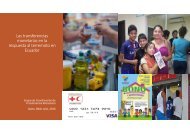Simatelele
2lF850q
2lF850q
You also want an ePaper? Increase the reach of your titles
YUMPU automatically turns print PDFs into web optimized ePapers that Google loves.
2. SAVE THE CHILDREN’S<br />
E-TRANSFER PROJECT<br />
2.1 PROJECT DESCRIPTION<br />
In response to the ongoing food security crisis, Save the Children launched the Emergency Food Security<br />
Cash for Training/Work Project (EFSP). The project lasted from October 2014 – July 2015, targeting 25<br />
wards in the Binga and Kariba Districts. Basic project details are summarized in Table 2, below:<br />
Table 2: Project Description<br />
LOCATION<br />
Project Length<br />
Total Number of Recipients<br />
Number of Cash Transfers<br />
Frequency of Cash Transfers<br />
Cash Transfer Amount<br />
Service Provider<br />
Donor<br />
BINGA & KARIBA DISTRICTS<br />
Nine months (September 23, 2014-July 31, 2015)<br />
Unconditional cash transfers began in October; conditional cash<br />
transfers began in November<br />
6,750<br />
Six<br />
Monthly<br />
28 USD<br />
Econet, an MNO, with a mobile money service called EcoCash<br />
United States Agency for International Development (USAID)<br />
EFSP was designed to support consumption and food security among the most vulnerable households<br />
through conditional and unconditional cash transfers. Binga district has been affected by chronic food<br />
security issues for many years. Few residents are formally employed, and few have productive farms that<br />
enable them to sell excess harvests. Humanitarian programs, including in-kind food assistance and cash<br />
transfer programs, have provided an important (though irregular) form of support for some residents.<br />
EFSP recipients received 28 USD per month intended to cover the cost of a specific “food basket”<br />
to improve household resilience and self-sufficiency in managing shocks. In exchange, 6,240 nonlabor<br />
constrained households participated in either conservation agriculture trainings or community<br />
rehabilitation and construction projects (and received cash transfers as a condition of their participation).<br />
Labor-constrained households (510) received the cash unconditionally. Over the life of the project, 6,750<br />
households were reached, totaling 30,237 indirect beneficiaries (14,751 males and 15,666 females). Sixty<br />
percent of transfers were distributed to female account holders.<br />
EFSP’s transfer amount was set to cover contents of a specific food basket and fees for a single cash-out,<br />
and there was no expectation that funds would be sufficient to cover other expenses or for savings. As<br />
such, the project was not designed to promote savings, or the use of other financial services associated<br />
CAN E-TRANSFERS PROMOTE FINANCIAL INCLUSION IN EMERGENCIES: A CASE STUDY FROM ZIMBABWE 11



